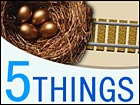Get your retirement plan on track
For dependable results, take a sweat-free approach to your longest-term savings.
February 22, 2002: 11:53 a.m. ET
|
 NEW YORK (CNN/Money) - No matter your investing IQ, you don't have to be a genius to set up a smart retirement plan.
NEW YORK (CNN/Money) - No matter your investing IQ, you don't have to be a genius to set up a smart retirement plan.
But you do have to master three secrets of success in long-term investing: automated savings, self-discipline, and variety. In other words, making steady-as-she-goes contributions to a well-diversified portfolio. That means staying the course when you'd rather hide under the covers, and playing a cool hand when the market gets hot.
With that in mind, here are five easy-to-execute ideas that will add heft to your nest egg without adding sweat to your brow:
Don't let a dull or down market dissuade you: In many instances, there's money to be made no matter the market's mood, but it won't pay if you don't play. Dollar-cost averaging -- investing a consistent amount of money at regular intervals -- reduces your investment risk because you buy shares in a company or mutual fund at all pricing levels, which lowers your average cost per share over time. That's because when you buy in a down market, it's the equivalent of shopping when the shares are on sale -- you can purchase more for less.
Your company 401(k) provides a golden opportunity for dollar-cost averaging, since an amount of your choosing is automatically withdrawn from every paycheck. What's more, it provides you with tax-deferred compounding, which allows your money to grow faster than it ordinarily might.
Get the right asset allocation. Of course, even if you keep both feet in the market, you risk amputation if you place the majority of your bets in one sector, stock or investment style. That's because no part of the market is safe from loss and no one type of company is always in favor. That's why it's important to invest in a sound mix of stocks and bonds that is appropriate to your age and risk tolerance, and to allocate your money across industries (e.g., manufacturing, telecom), investment styles (e.g., growth, value), and company size (e.g. large-cap, mid-cap). The key, too, is not to be overly aggressive or too conservative.
For help determining how close you are to meeting your retirement savings goals, play Moneyville.
Being well diversified minimizes your losses over the long term since you don't put all your eggs in one basket, and therefore aren't fully exposed to the market's biggest losers at any point. It also increases your chance for exposure to the market's winners at any given time. The goal is to have money in an array of investments that don't move in lockstep with each other. (For more, read our asset allocation primer. For help in finding the right asset allocation for you, use our Fix Your Mix tool. And if you want help picking solid-performing mutual funds, check out the Money 100.)
Don't forfeit free money: If your employer offers a matching 401(k) contribution, contribute at least enough to get the full match. Otherwise, you lose a key part of your job compensation and pass up an excellent opportunity to pad your nest egg. Better still, max out your 401(k) contributions if you have an emergency fund in place and doing so won't rob you of cash needed to pay for the necessities of life. (Remember, if you've got kids, your retirement needs should rank higher than your desire to pay for their college education. They can always take loans and get aid, but no one is going to give you a scholarship in your later years. If you still need convincing, click here.)
For 2002, the federal limit on annual, tax-deferred 401(k) contributions has gone up to $11,000 ($12,000 if you're 50 or older). Next year, the limit increases to $12,000 ($14,000 if you're 50 or older). Keep in mind, however, while federal law sets the guidelines for what's permissible in 401(k) plans, your employer may set tighter restrictions or may not have amended your plan yet to account for the new contribution limits.
Bump up your IRA contributions: Limits for IRA contributions are also on the rise. For 2002, you're allowed to contribute $3,000 to your IRA ($3,500 if you're 50 or older). And you still have until April 15 to make a contribution for the 2001 tax year. But remember, the limit for 2001 is $2,000.
For a quick primer on the types of IRAs you can invest in, click here.
Don't dip into your nest egg. After mustering the self-discipline to save a pot of gold, don't then deny yourself the best chance for a comfortable retirement by raiding the cookie jar early.
In most instances, taking early withdrawals from a 401(k) or IRA before age 59-1/2 means you'll pay a 10 percent penalty plus income tax on the withdrawal. What's more, you'll lose the opportunity to make money on your money, since there will be less left in your account to compound over time.
If you take a 401(k) loan, the damage to your nest egg is less severe, but hardly negligible. Even though you must pay yourself back with interest, that interest is not tax-deductible. And you pay the principal back using after-tax money. Essentially that means whatever you borrow is double-taxed. The loan repayment has already been taxed once, and then that same money will be taxed again when you withdraw it at retirement.
When you're in a pinch, cheaper, alternative sources of money include an emergency fund if you have one, a loan from a relative or friend, and a home equity loan (but only if you're sure you can make the payments required -- otherwise you risk losing your home). 
|
| SPECIAL: |
|
|
|
|
|

|

